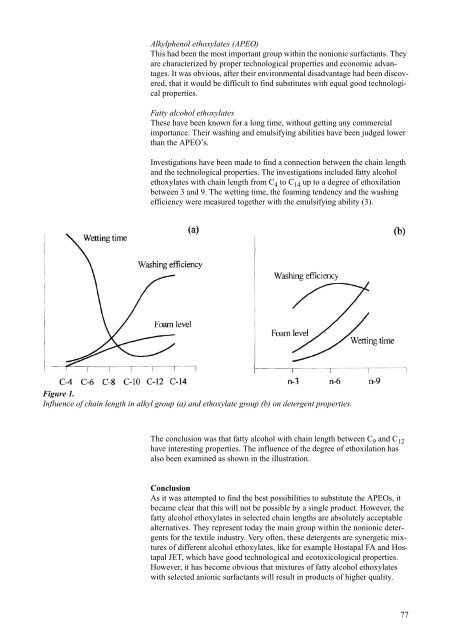Cleaner Technology Transfer to the Polish Textile ... - Miljøstyrelsen
Cleaner Technology Transfer to the Polish Textile ... - Miljøstyrelsen
Cleaner Technology Transfer to the Polish Textile ... - Miljøstyrelsen
You also want an ePaper? Increase the reach of your titles
YUMPU automatically turns print PDFs into web optimized ePapers that Google loves.
Alkylphenol ethoxylates (APEO)<br />
This had been <strong>the</strong> most important group within <strong>the</strong> nonionic surfactants. They<br />
are characterized by proper technological properties and economic advantages.<br />
It was obvious, after <strong>the</strong>ir environmental disadvantage had been discovered,<br />
that it would be difficult <strong>to</strong> find substitutes with equal good technological<br />
properties.<br />
Fatty alcohol ethoxylates<br />
These have been known for a long time, without getting any commercial<br />
importance. Their washing and emulsifying abilities have been judged lower<br />
than <strong>the</strong> APEO’s.<br />
Investigations have been made <strong>to</strong> find a connection between <strong>the</strong> chain length<br />
and <strong>the</strong> technological properties. The investigations included fatty alcohol<br />
ethoxylates with chain length from C 4 <strong>to</strong> C 14 up <strong>to</strong> a degree of ethoxilation<br />
between 3 and 9. The wetting time, <strong>the</strong> foaming tendency and <strong>the</strong> washing<br />
efficiency were measured <strong>to</strong>ge<strong>the</strong>r with <strong>the</strong> emulsifying ability (3).<br />
Figure 1.<br />
Influence of chain length in alkyl group (a) and ethoxylate group (b) on detergent properties.<br />
The conclusion was that fatty alcohol with chain length between C 9 and C 12<br />
have interesting properties. The influence of <strong>the</strong> degree of ethoxilation has<br />
also been examined as shown in <strong>the</strong> illustration.<br />
Conclusion<br />
As it was attempted <strong>to</strong> find <strong>the</strong> best possibilities <strong>to</strong> substitute <strong>the</strong> APEOs, it<br />
became clear that this will not be possible by a single product. However, <strong>the</strong><br />
fatty alcohol ethoxylates in selected chain lengths are absolutely acceptable<br />
alternatives. They represent <strong>to</strong>day <strong>the</strong> main group within <strong>the</strong> nonionic detergents<br />
for <strong>the</strong> textile industry. Very often, <strong>the</strong>se detergents are synergetic mixtures<br />
of different alcohol ethoxylates, like for example Hostapal FA and Hostapal<br />
JET, which have good technological and eco<strong>to</strong>xicological properties.<br />
However, it has become obvious that mixtures of fatty alcohol ethoxylates<br />
with selected anionic surfactants will result in products of higher quality.<br />
77

















